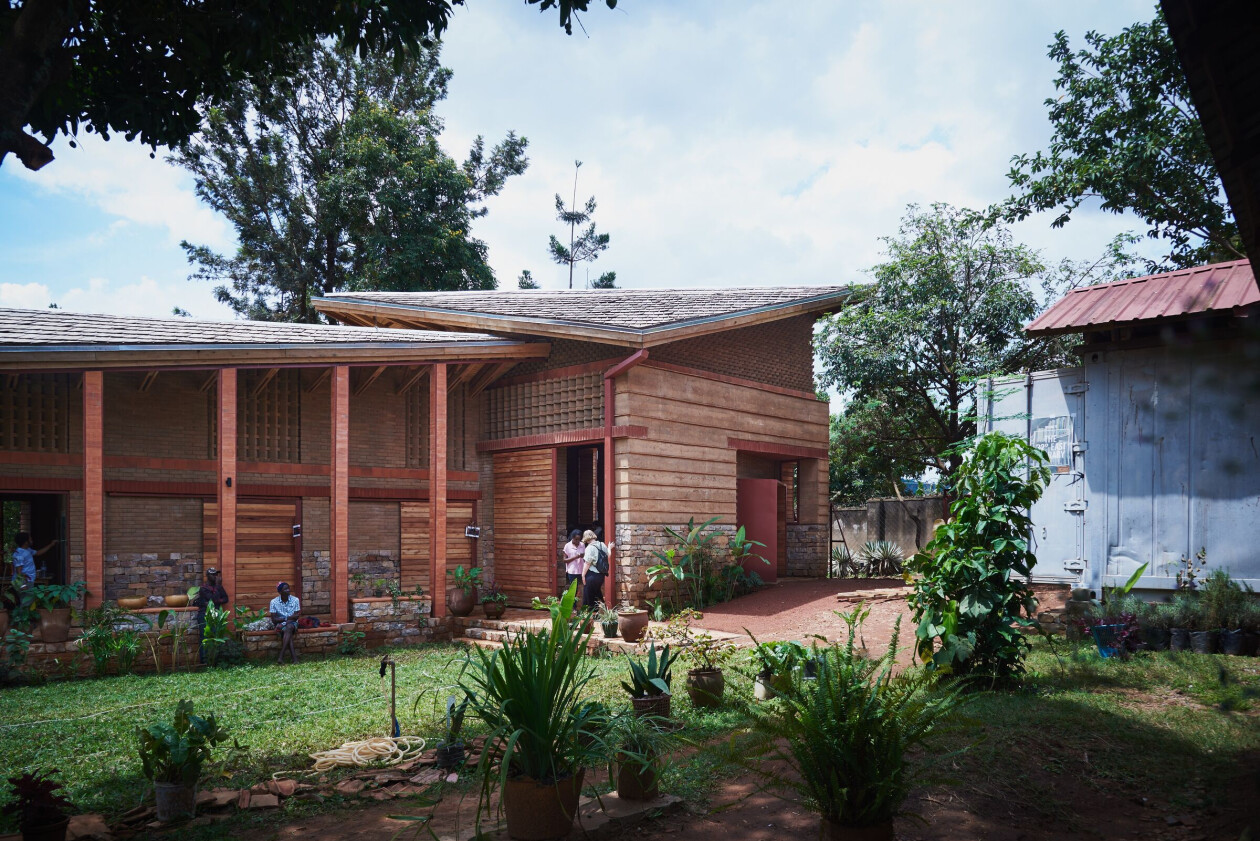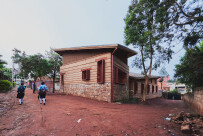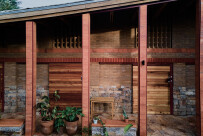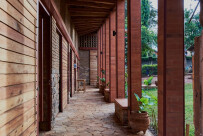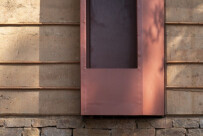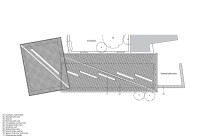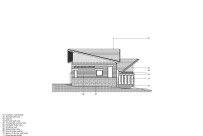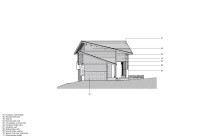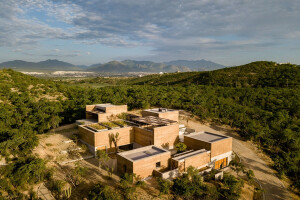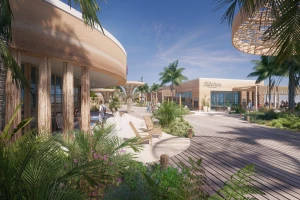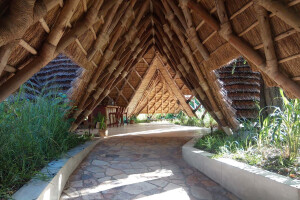32° East Arts Centre is Kampala’s first purpose-built community arts space and the new home of 32° East | Ugandan Arts Trust. Located in Kabalagala, a central neighborhood in Kampala, the centre is a creative hub for the city’s artist community: it provides a welcoming, inspiring, and nurturing space — a place where artists can work and socialize. The arts centre was designed by London-based New Makers Bureau in collaboration with Kampala-based Localworks. New Makers Bureau places a great emphasis on architecture that is craft-led and low in embodied carbon; Localworks is a multidisciplinary design and build studio specializing in ecological architecture.
32° East Arts Centre is a building constructed using rammed earth and earth brick. A development in two phases, the project’s first phase was seven years in the making — it officially opened on 23rd March 2023. This phase consists of four artist studios, a library, restrooms, and a flexible cafe. The cafe will function as a temporary gallery and workspace until the second phase is completed (due at the end of 2024). This phase will include a gallery and mezzanine, additional artist studios, artist accommodation, kiosks, and a walled courtyard.
Originally housed in four shipping containers, the building of a new hyperlocal, low-carbon arts centre represents a radical departure from 32° East’s former home. Its construction follows circular economy principles, using materials already available on the site. In an interview with James Hampton, Founding Director of New Makers Bureau, he discusses various aspects of the arts centre’s design and construction. “We started working with 32° East | Ugandan Arts Trust about seven years ago. It was at the time when they were looking for a new site for their existing set-up — a collection of shipping containers,” says Hampton. “The 'project' didn’t really exist at that point. Through discussions with the Trust’s director, Teesa Bahana, we started to think about the potential of a purpose-built centre and what it would mean to the artistic community in Kampala.”
A local collaboration
In order to realize the arts centre project in Kampala, it was important that New Makers Bureau collaborated with a local studio. In Localworks, they found a partner whose approach is rooted in the principles of sustainable architecture. “Over the years we developed a very close relationship with Localworks,” says Hampton. “On our various visits we would hold design workshops and go to see their projects and others in order to gain a better understanding of the local context. We were hugely inspired by Localworks — by the work they do and the way they do it. They have become experts on the use of earth in construction.”
The challenges of working in an East African environment are numerous. They include climate, terrain, economic and logistical considerations, the availability of materials, and skilled labor. “Without excellent local collaborators, we would have found it almost impossible to design and construct the 32° East Arts Centre,” says Hampton. “There are certain elements, the roof design in particular, that differ from a non-tropical context, whereas others, including thermal mass and natural ventilation, share similarities.”
The site
Attracting artists from across the East African region, a central location for the new arts centre was key. As Uganda’s capital, Kampala is a bustling and dynamic city with a vibrant cultural and contemporary art scene. “KLA ART”, for example, is a contemporary art festival in Kampala that is produced by 32° East. “The arts centre site is a short walk from Ggaba Road, a busy thoroughfare that runs from Lake Victoria into the centre of the city,” says Hampton. “Although it’s close to this busyness, it’s also very secluded and quiet, sitting on a smaller side road which connects to Kampala University.” New Makers Bureau designed built-in seating on the site as a way to encourage impromptu social moments.
Describing the location, Hampton explains: “The site itself is very sloped, about 3 meters from one side to the other; it’s a corner plot and is roughly square in plan form. It lent itself to a courtyard building — phase 2 will complete the courtyard. There are views into and an openness of the courtyard, which also feels both contained and secure because the walls are so thick.”
The foundations are made using a solid local sandstone. “We were exploring ideas of excavation/archeology and have literally taken the building from the ground, mining the site for the material,” says Hampton.
Construction, materials, and texture
The arts centre is made from a mix of rammed earth and earth bricks, created with rich red-colored earth taken directly from the site.
“Formwork for the rammed earth was built using local eucalyptus timber in lifts of around 400mm — the timber was then re-used for the roof shingles," says Hampton. "The earth is sifted, mixed with sand and lime, and then compressed with a pneumatic press, compacted to about half of its original size. This is completed in a horizontal row; the formwork is then lifted up in order to create the next level and so on. If you look closely, you can see the lines on the walls between the lifts. Later, we added rows of clay tiles which protrude by 20mm, helping to throw water away from the face of the walls. These tiles are more spaced out as you go up, because the amount of rain falling on the walls is greatest at the base."
Hampton continues: “The earth bricks are a similar mix to the walls and are pressed using a purpose-built machine to our particular dimensions - the bricks are thinner than a conventional brick. They are then dried for around two weeks before they are ready to use. The bricklayers were very careful to retain the 'crispness' of the brick, which can sometimes be a bit flaky on the edges. There was real attention paid and skill devoted to the placement and selection of each brick.”
When working with purely local, earth-based materials “there’s a real sense of tactility to the building, one that invites touch,” says Hampton. “In certain moments it’s very smooth and in others, a little rough — although never too rough. The building feels cool because of the high thermal mass; visually, it is very warm and soft. It also feels like it's been there forever - the deep clay content of the earth gives the whole city of Kampala a warm pale red hue and the building sits within this.”
The arts centre has a beautiful kaleidoscope of color and texture, with materials placed in a range of contexts. Hampton explains: “Generally, the different brick textures have a purpose - there’s an open ‘hit and miss’ texture which allows airflow and dapples of sunlight, a textured pattern which is generally in more exposed areas, and a more standard brick bond. Light conditions in Kampala are extreme and this tends to show up any inconsistencies in large expanses across the surfaces. The texture therefore works to resolve this issue — we purposefully wanted to make a textural building that enjoys changing patterns of light and shadow throughout the day.”
Designing for a tropical climate
The arts centre’s careful design incorporates a number of strategies to temper the sun’s intensity, from the use of slim polycarbonate roof lights for natural daylighting to the aforementioned “hit and mix” textured open brick, aiding airflow and dappled light.
Cognizant of the region’s climate, New Makers Bureau designed a roof for the arts centre with a shape that is both expressive and protective. The eucalyptus roof shingles were created from the rammed earth formwork. “Roof forms are very important in a tropical climate: you want lots of shade and a place to shelter from the heavy rain,” says Hampton. “Moreover, in the case of this building, the roof is a way to prevent erosion of the earth walls — large overhangs are a must. We took the centre pitch of the roof and gave it a direction — the cafe roof opens to the entrance and welcomes people in. Internally, owing to the diagonal twist, the roof trusses are all different and describe a gentle curve that can be seen on the colonnade and cafe interior in particular.”
“The large roof overhangs provide shade,” says Hampton, “and the pop-out boxes for the windows prevent the penetration of direct sunlight into the building.” The building’s overall volume plays a significant role: “The earth and stone walls are thick, with a high thermal mass that helps to cool the structure” explains Hampton. “The open brickwork and windows combine to create airflow — the artist studios have lower openings on the outer elevation and high open brickwork, helping to create air movement.”
Carbon
The overall use of passive techniques, avoiding mechanical systems for ventilation and cooling, reduces maintenance costs for the arts centre and will restrict operational carbon across the building’s lifetime.
“We don’t have operational carbon data as yet,” says Hampton, “but have calculated the embodied carbon to be less than 200kg CO2 e/m2. This assumes a fair amount of cement in the earth mix, so it may in fact be less in practice. We saved a huge amount of embodied carbon in the foundations which are made from the same stone as the building rather than concrete.”
Phase 2
Fundraising for phase 2 of 32° East Arts Centre is now underway, with plans to start on-site next year. The construction will take around nine months. “What’s really exciting is that as a team, we have developed a deep understanding of the build, the materials, and the particular challenges of the project,” says Hampton. “We can now apply this knowledge to phase 2, which is more ambitious, almost twice the size, and a little more complex."
Working on a pro-bono basis, 32° East Arts Centre has been a pivotal project for New Makers Bureau, particularly in terms of climate-focused design. “Collaborating with other architects, engineers, and designers, and learning from them, has been one of the most rewarding aspects of the project,” says Hampton.
About 32° East | Ugandan Arts Trust
As an independent, non-profit organisation, 32° East | Ugandan Arts Trust focuses on the creation and exploration of contemporary art in Uganda.
